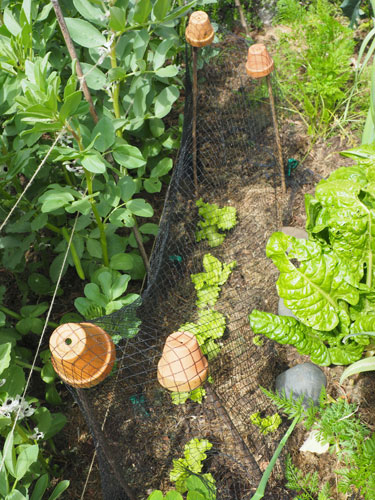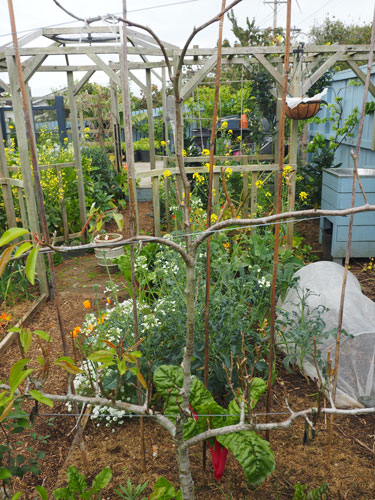Living well by design
Jenny Marshall insists she and her husband Mark are very ordinary people. But there is nothing all that ordinary about converting your entire front garden into a vegetable garden. Living without a car is even less common, not something ordinary kiwis do. At least, not yet.
According to Jenny, it’s easier than we might think, and her garden is living proof that you don’t need to own a lifestyle block to grow most of the food you eat. She and Mark would have quite liked a bigger bit of land, but that would have meant moving further out from the city and, with transport emissions being such a huge driver of climate change, they were determined to live where they didn’t need to own a vehicle.
“We needed somewhere in a walkable neighbourhood with good access to public transport. I also wanted somewhere that was zimmer frame-friendly so when I can get older, I can stay put!” she adds. One other criterion during their house hunt was good orientation to the sun, important to achieve their ideal energy-efficient home with passive heating. And so it was that Cornwall Pocket Farm was found. On a 300m2 section close to Cornwall Park in Onehunga, their renovated 1950's home is very well insulated with large, double-glazed windows that look northward into the garden.
Rethinking perfection
Jenny describes her garden as a ‘working farm’. This is not a tidy garden with a lawn and manicured borders. Rather, it is a colourful haven bustling with wildlife, and a scene that is ever changing. In early spring when we visit, the yellow brassica flowers are abuzz with bees. Bright orange nasturtiums and scented alyssum delight the senses. Roses and grapevines are bursting their buds on the pergola overhead, soon to be providing the all-important summer shade for the kitchen and living areas. “When we came here, there was just concrete and kikuyu grass,” says Jenny. “There was no life. Now I’m looking at bees, fantails and something new bursting into bud or bloom every day.”
Before Cornwall Pocket Farm, Jenny’s busy lifestyle had left no time for gardening. Then, while living in an apartment during their renovation, she spent six months finding out as much as she could, discovering YouTube as a great source of inspiration. Five years on, she is making YouTube videos of her own (@cornwallpocketfarm), regularly sharing her hands-on learnings with others. “I want to show other people what can be done and hopefully give them some pause for thought.”
No space to waste
“My mission is to grow as much as I possibly can in this compact space,” says Jenny. “But I had to figure out how to do this, so it was an attractive garden and make it low maintenance as well. I try to do everything as efficiently as possible because I’m really lazy!” At last count there were 29 fruit trees, including espaliered apples, pears, and quinces. An artfully pruned fig tree graces the garden’s entrance. There are citrus and olive trees in large pots and four avocado varieties planted together as one ‘family planting’, to achieve best pollination and staggered harvests.
“Of course, I don’t have room for full sized fruit trees, so I prune and train them to fit everything in. We don’t need full-sized trees because there are only two of us and we don’t need that much fruit. I aim for variety rather than too much of one thing.”
At the west end of the garden is a fan trained elderberry from which Jenny makes elderberry wine and her delicious jelly. A nearby passionfruit vine has wild strawberries growing beneath it, and a two-year-old dwarf banana palm, its roots kept confined in a planter box, has yielded two big bunches of bananas already. Vegetables grow in four main beds called England, Germany, France, and Italy. Jenny has found the beds shaded by the fence in winter are good for growing asparagus, which can do without full sun until its ferny foliage is growing over summer.
Another of Jenny’s space-saving tricks is to grow vegetables upwards wherever possible. Above her vegetable beds rises Crystal Palace, a central pergola that she uses to grow climbing vegetables like beans and squash. Two archways on either side are called Marble Arch and Arc de Triumph. For fun, she honours her tiny garden with grand names.
Upcycling
Jenny and her engineer daughter built the garden’s structures from repurposed rimu from the house renovation. “My daughter comes to help me on weekends. She gets well paid in food, which she loves because she lives in an apartment,” says Jenny. Everything in the garden is recycled, donated, or found. Many of Jenny’s pots are finds from the side of the road. Seedlings grow in cloches made from old window frames. An urbanite retaining wall, built to create a flat terrace for the vege garden, saved the expense of shifting piles of broken concrete off site. All the painted structures, including the chicken coop, Henley Hall, were built from a deconstructed car port.
Carbon capture
The overriding focus in Jenny’s garden, as in her home, is the environment. Caring for her soil is, for her, as much about locking away greenhouse gases as it is about growing healthy food.
“When I first found out about climate change, I was flabbergasted! I thought it was a joke and then I saw it was real! We are making a planet that isn’t going to be habitable for human beings in a large number of places. When I saw a video that asked, ‘Once you knew, what did you do?’ I decided, ‘I can’t carry on like this. I can’t pretend this isn’t happening!’”
Big changes didn’t happen overnight. “We had started with things like recycling and taking our own bags to the supermarket,” says Jenny. “Then we just continued to work small changes into our lives.” She presses on with her personal journey while celebrating all the baby steps we all make to help the planet as much as we can.
Soil health and biodiversity
Realising that healthy soil is one of the most important tools in the fight against climate change, Jenny keeps her soil covered with a diverse range of plants, digging as little as possible and constantly feeding it with organic matter.
She doesn’t have room for a conventional compost heap, instead using a variety of simple ways to recycle all her organic waste and build soil humus. “I try and integrate it all, so it all works seamlessly and under the surface. My chickens do a lot of the work for me.” In one of her YouTube videos, she explains eight different ways to make compost in a small city garden (@cornwallpocketfarm).
For mulch, Jenny uses lawn and hedge clippings, which her neighbours are happy to supply. “It’s brilliant - the young lads bring it around every time they mow or clip!” Jenny’s preferred planting style is to mix everything up. Because, she says, a healthy soil biome needs that diversity of planting. “Instead of planting a whole bed of one thing I tend to plant the same thing in multiple places. I also aim to have plants at various stages of maturity so there is always something ready to eat.”
She doesn't weed. “I plant densely so there is not much room for weeds to grow! If there are weeds, I think I must put more plants in, but I leave them there until I plant something else because their roots are supporting soil life,” she explains. Similarly, she will only remove a spent vege plant when she has another flower or vege plant to put in its place. Wherever possible, she will simply cut off the finished crop, leaving its roots in the soil. In theory, all that mixed up variety should help to minimise pests. But other than covering young seedlings to protect them from the birds, Jenny says she doesn’t worry about pest control. “I just think well, that’s nature and I let nature get on with it.”
“I get my tomato seedlings started early in the conservatory and have plants at all stages of growth. Sometimes the early ones do well, sometimes the later ones are better. Sometimes they all do well. I suppose I hedge my bets a lot!”
Succession planting
Looks can deceive. It turns out that this thriving jumble of nature doesn’t quite happen all by itself. There is some meticulous planning going on behind the scenes to achieve this highly productive, low-maintenance plot. “To get a continuous harvest I sow a bunch of seeds every fortnight. Then every other week I will pot on whatever needs it.” Unlike others who have been gardening for years, Jenny says she had no prior knowledge of traditional practices. She is not afraid to break rules in figuring out what works for her. She has developed her own spreadsheets for sowing and planting, which she now shares via her online workshops.
A new way to eat
For the good of the planet, and with a little bit of encouragement from their vegetarian daughters, Jenny and Mark have switched to a vegetarian diet. Jenny is the grower and Mark is the cook, although she does the baking. They opted for a good-sized pantry so that groceries could be delivered in bulk once every three months and plastic packaging is largely avoided.
“We used to do that thing where you go ‘What do we want for tea’ and then head to the supermarket to buy it, whether it was seasonal or not. Now we say, ‘What have we got in the garden and what can we make with it?’ It took a while to get the hang of but now it’s exciting to think, ‘Oh this will be ready soon!’”
Now they are enjoying their asparagus, broccoli, peas, and leeks. Soon it will be the broad beans, and the anticipation of their first tomatoes. Once settled into their new life, the couple realised they could easily manage on Mark’s one income. “Before we were both working like mad, like hamsters on a wheel,” says Jenny. “Our new lifestyle is so much cheaper. We have so much more time now, it is much more relaxed, more comfortable and the food is so much better. We are healthier and fitter. There are just so many positives!”
Book a visit to Jenny's garden, or participate in one of her workshops, via the new garden-share platform Secret Gardens at secretgardens.co.nz.

15-Nov-2023

I want to show people what can be done and hopefully give them pause for thought.

No space to waste

I don't have room for full-sized fruit trees so I prune and train them to fit everything in.

I try to integrate it all so it all works seamlessly and under the surface. My chickens do a lot of the work for me.

Broken concrete is repurposed as steps and retaining walls.

An old bird cage found on the side of the road, makes a useful bird barrier.

Jenny's front entrance is both attractive and functional.

